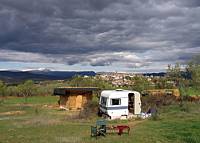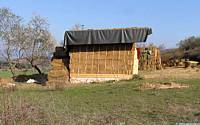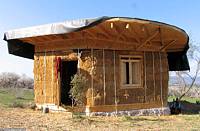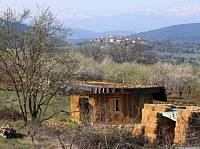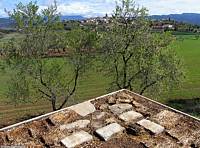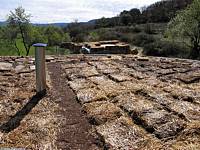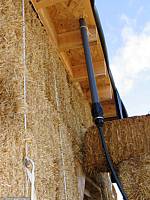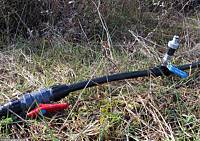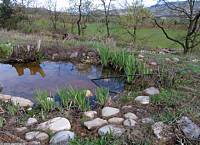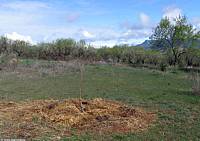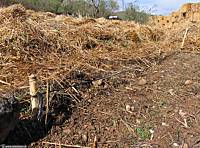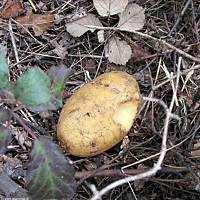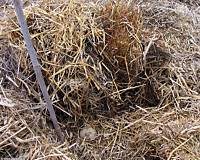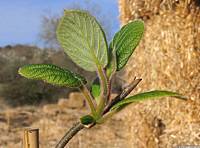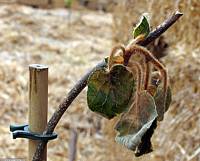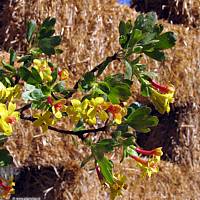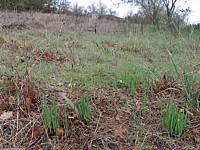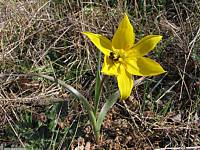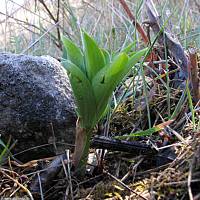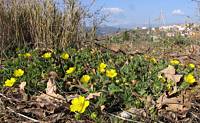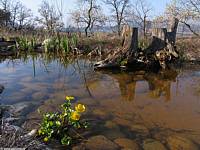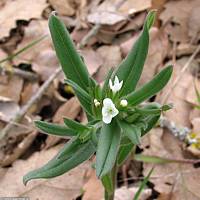|
|
Nature
Switched On
|
|
|
introduction |
2009 March 27 to 29, Friday to Sunday
|
|
|
This weight and the roof in general have recently been the focus of
some worrying. - the irregular shape and weight distribution of
the roof
|
||
| The white
cordstraps clearly indicate an inclination to the right. Photograph taken on 22 March 16:52 |
||
| 3 extra
braces under the overhang. Looking north. Photograph taken on 22 March 16:47 |
||
| After
installing the braces (with the help of a car jack), the roof line doesn't show any
substantial dip. Looking north. Photograph taken on 22 March 16:28 |
The east corner with 9 heavy
stones on the roof. Looking east. Sunday 12:06 |
|
|
As mentioned at the beginning, the rainfall on Saturday night was a
nice test for the roof. The day before I had installed a provisional
rainwater harvesting system. It takes the water from the roof to the
ponds by gravity through a 150m long hose of polythene. The idea was to make use of my
water pump and use the same hose to transport water in the
opposite direction and irrigate the vegetable garden and fruit trees
with water from the ponds.
After the rain of Saturday night I didn't detect any puddles on the roof so I suppose some water will have reached the pond but probably most of the 500 litres will have been absorbed by straw and soil. |
||
|
The temporal straw flakes on the
roof, heavy with rainwater. Sunday 12:02 |
||
| Rainwater
outlet (PVC) connected to rainwater harvesting system (PE). Sunday 12:09 |
Faucets to divert water from the ponds to vegetables and fruit
trees. |
|
| Water
still clear in the upper pond after the inlet of rainwater. Sunday 10:59 |
||
|
Straw is abundantly used as mulch in the vegetable garden. I also
used straw to fill up the mulch basins around the fruit trees. The
basin walls were sown with White clover (Trifolium repens
'Huia')
and Bird's foot
clover (Lotus corniculatus) to provide for
nitrogen fertiliza I planted potatoes (early; 'Jaerla') under a
mulch layer of 30 cm. In theory we will just have to pull up this
layer to harvest the potatoes in summer. The same afternoon I saw a
potato I had just thrown on an improvised compost heap because it
started to rot and it was immediately attacked by mice...
|
Mulch basin with a
diameter of 2m for a Kaki tree. |
|
| White
clover is also sowed in most vegetable beds. Here massively
germinating in a bed of perennial Welsh onion (Allium
fistulosum; not germinated yet). Sunday 11:29 |
|
|
| Potato
planted under a bed of 30 cm straw. Saturday 15:00 |
||
|
The growing season has just begun but some of the hazards that
unnerve the gardener have already presented themselves. It is
precisely straw that can have some adverse side effects. One of them
is the obstacle it can form for the earth to radiate its warmth to
plants at night, which are in this way more exposed to frosts. This
is exactly what happened
Exceptionally early and having no problems with any frost is this Buffalo currant (=Clove currant; Ribes odoratum=R. aureum). It has a very pleasant spicy fragrance that permeates the whole garden. In the Netherlands it is nominated for an official neophyte as it is spreading naturally, partly because of climate change. |
A Kiwi plant spreading joyously its leaves... Photograph taken on 21 March 9:20 |
|
|
Leaves and flowers of the Buffalo currant are weeks ahead of other Currants. It is often grown for its scent and beautiful colours in spring and autumn, and less for its berries with many pips. Sunday 11:36 |
..and one week later, after some
light frost. Saturday 14:56 |
|
|
The almost weekly inspection on the bulb front: on many places but in few numbers come the Grape hyacinths (Muscari neglectum). Very promising is the appearance of Gladiolus illyricus on many new places; not completely spontaneous because I helped the reproduction somewhat, sowing some harvested seeds last summer. Completely spontaneous is the proliferation of the Lady orchid (Orchis purpurea) which is appearing also on many new places. |
||
|
Grape hyacinths. Photograph taken on 21 March 17:02 |
Dozens of emerging
Gladiolus illyricus on the
central terrace. Sunday 10:38 |
|
|
|
||
|
Tulipa sylvestris with a honey bee. Friday 15:19 |
||
|
Lilium martagon. Sunday 13:52 |
||
|
The Creeping Cinquefoil (Potentilla
reptans) started to flower on relatively dry areas.
I detected about 10 plants of a new species: Field Gromwell (Lithospermum arvense). It is an annual species, typical for disturbed, lime-rich soil. It became so rare in the Netherlands that it was introduced on the red list. |
||
|
Potentilla reptans on the central terrace. The graminea at
the back isn't reed but the short Brachypodium retusum. Looking north-east. Photograph taken on 22 March 16:34 |
||
|
Caltha palustris in the upper pond. Looking east. Photograph taken on 21 March 17:06 |
Sparganium erectum
spreading. Saturday 15:13 |
|
|
Lithospermum
arvense on the central terrace. Saturday 14:47 |
||
|
introduction
|
|
